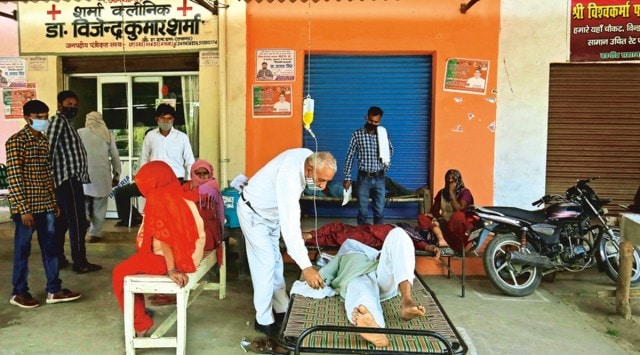- India
- International
Active caseload thrice last year’s peak, a lone doctor struggles to cope with flood of patients in Saharanpur
Primary Health Centre is shut, CHC not declared Covid centre yet, both wait for stocks of vaccines.
 Dr V K Sharma with a patient at his clinic in village Bargaon in Saharanpur on Thursday. (Photo: Praveen Khanna)
Dr V K Sharma with a patient at his clinic in village Bargaon in Saharanpur on Thursday. (Photo: Praveen Khanna)The patient is weak and gasping for breath, Dr V K Sharma can barely hear him speak. But he puts his hand on the patient’s chest, checks the makeshift saline drip on a rickety pole, and utters the same words of reassurance that he says he has most often used throughout his 45-year practice. “Bas sardi-khansi hai, thik ho jaoge (It’s just a cold and cough, you will be fine).”
But Dr Sharma knows it’s different this time.
The words are more placebo than truth. “Should I tell them they could die?” he says.
Over the past few weeks, Sharma’s one-room clinic on the roadside at Bargaon village in Saharanpur on Uttar Pradesh’s north-western tip has been handling a deluge of patients with Covid symptoms.
It’s a snapshot of the grim challenge that India’s most populous state, which has the fourth highest active caseload in the country with 2.6 lakh cases, faces in the second wave that has engulfed big cities and is now battering rural districts such as Saharanpur.
Official figures show that 378 new cases and one death were recorded in Saharanpur on April 29 alone. Just a week later, on May 6, the number of new cases stood at 687 with seven deaths and an active caseload of 5,893.

This seems to be a world away from last year’s scare when at the peak of the first wave, the district’s daily caseload peaked at 201 on September 3, and the active caseload five days later with 1,858 cases.
But in villages like Bargaon, that time-out, like in most parts of the country, wasn’t used to ramp up public healthcare, which is virtually non-existent. The block headquarters in Nanauta is 12 km away, Saharanpur town 33 km, and the nearest big town, Muzaffarnagar, 43 km. And so, it has fallen on doctors like Sharma, an Ayurveda graduate, to handle the surge.
Inside his clinic, a small wooden partition separates his table and chair, and the examination bed. On Thursday morning, occupying the bed inside, the ledge, and portions of his table, are 10 patients. Outside the sliding door of the clinic, under an aluminium covering, are six cots, all occupied, three with saline drips. Next to them are at least 30 people, some anxious family, others suffering themselves.
Just about a month ago, Sharma would have “five-ten patients a day”, now his clinic has upto 100 coming in a single day. “Not one of my patients has died,” Sharma says proudly. Yet, there is an important caveat. He only treats patients with an oxygen level higher than 92 on a pulse oximeter. Below that, he asks them to go to hospital.
“What can I do? I can only help treat symptoms and comorbidities for very mild patients and try that their infection doesn’t escalate,” Sharma says.
But now, even this has become increasingly difficult.

The medicines that Sharma prescribes, such as azithromycin and dexamethasone, are not available in the village’s medical stores, and those in the towns are running short. “Everything is becoming more expensive, too. You see those bags for the drip? They used to be available for Rs 350. Now, you can’t get them for Rs 900. We are getting patients from villages around as well. People are dying, the fear is everywhere,” Sharma says.
On one of the six cots outside is the wife of Raju Kumar — she had collapsed five days ago at her home in Khedi village. Kumar took his wife to the CHC in Nanauta, to the district hospital in Muzaffarnagar, to Saharanpur, but hit a wall everywhere. They asked him for a Covid test, but the testing centres were all shut, he says.
“We have come to this doctor after failing to get any relief from the government. In the villages, there is a cold and cough, and then they are dying. This never happened last year. The government says there is healthcare. They say take vaccines. Where? Do they know all their centres are always closed?” says Kumar.
Less than a kilometre from Sharma’s clinic is the Bargaon PHC. On Thursday morning, only its rusted gate is open. Every room inside has a lock on it, and is completely empty. There are four men milling around. One ambulance driver, one ambulance EMT, a government ayurveda practitioner, and the PHC ward boy.
The ward boy, Sahjad Ahmed, says vaccination does take place but there has been no supply for the last two days. “Last month, we used to conduct at least 100 vaccinations every day. But now, the vaccines come only three-four days a week. The doctor in charge is unwell himself. Some months ago, the nurse was transferred out. If someone comes to get vaccinated, we tell them to go to the CHC in Nanauta,” he says.
That CHC, which caters to 80 villages, is empty as well. Dr Pramod Kumar, the doctor in charge, says, “Vaccinations happen here, but the supply hasn’t come today. We will restart whenever they come.”
At the CHC, there is a room that says ICU but with no patients inside. “We are not a Covid-declared centre yet. Right now, we have only three doctors. If this becomes a centre, more from the district headquarters will have to come… But yes, this is becoming a hotspot. In the block, we have 194 confirmed cases in home isolation. And there have been 16 deaths,” says Kumar. How many of them in the last two months during the second wave? “All of them.”
If the government believes that vaccination is the long-term solution, data from rural Saharanpur show that the number of jabs is not only low, but dropping.
Nanauta block has a population of just under 2 lakh. And CHC records show that from March 1 to April 7, there were 6,985 first doses and 5,063 second doses administered, all of Covishield.
In April, that number dropped drastically. Between April 7 and May 6, records show there were 3,845 first doses and 1,009 second doses of Covishield, and 509 first doses and 174 second doses of Covaxin. Vaccination for the 18-45 age group hasn’t started yet.
Back at Bargaon, Sharma feels compelled to step outside his clinic — this time, to disperse the growing crowd of family members of patients. But three men with face masks, lending a shoulder to an elderly man, stay put. “Please take a look,” they say. The man’s breath is heavy, his eyes are dimming. But Sharma’s clinic has no beds left.
Must Read
Apr 23: Latest News
- 01
- 02
- 03
- 04
- 05






































